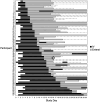Transition to Enteral Triazole Antifungal Therapy for Pediatric Invasive Candidiasis: Secondary Analysis of a Multicenter Cohort Study Conducted by the Pediatric Fungal Network
- PMID: 39513400
- PMCID: PMC12476979
- DOI: 10.1093/jpids/piae116
Transition to Enteral Triazole Antifungal Therapy for Pediatric Invasive Candidiasis: Secondary Analysis of a Multicenter Cohort Study Conducted by the Pediatric Fungal Network
Abstract
Of 319 children with invasive candidiasis, 67 (21%) transitioned from intravenous to enteral antifungal therapy. Eight (12%) transitioned back to intravenous antifungal therapy, one due to perceived treatment failure defined by clinical progression or worsening. Global treatment response at study completion was successful in 66 participants who transitioned to enteral therapy.
Keywords: antifungal agent; candidemia; fluconazole; invasive candidiasis; oral drug administration.
© The Author(s) 2024. Published by Oxford University Press on behalf of The Journal of the Pediatric Infectious Diseases Society. All rights reserved. For commercial re-use, please contact reprints@oup.com for reprints and translation rights for reprints. All other permissions can be obtained through our RightsLink service via the Permissions link on the article page on our site—for further information please contact journals.permissions@oup.com.
Figures

References
-
- Steinbach WJ, Roilides E, Berman D, et al. ; International Pediatric Fungal Network. Results from a prospective, international, epidemiologic study of invasive candidiasis in children and neonates. Pediatr Infect Dis J 2012; 31:1252–7. - PubMed
-
- Nucci M, Colombo AL, Petti M, et al. An open-label study of anidulafungin for the treatment of candidaemia/invasive candidiasis in Latin America. Mycoses 2014; 57:12–8. - PubMed
Publication types
MeSH terms
Substances
Grants and funding
LinkOut - more resources
Full Text Sources

